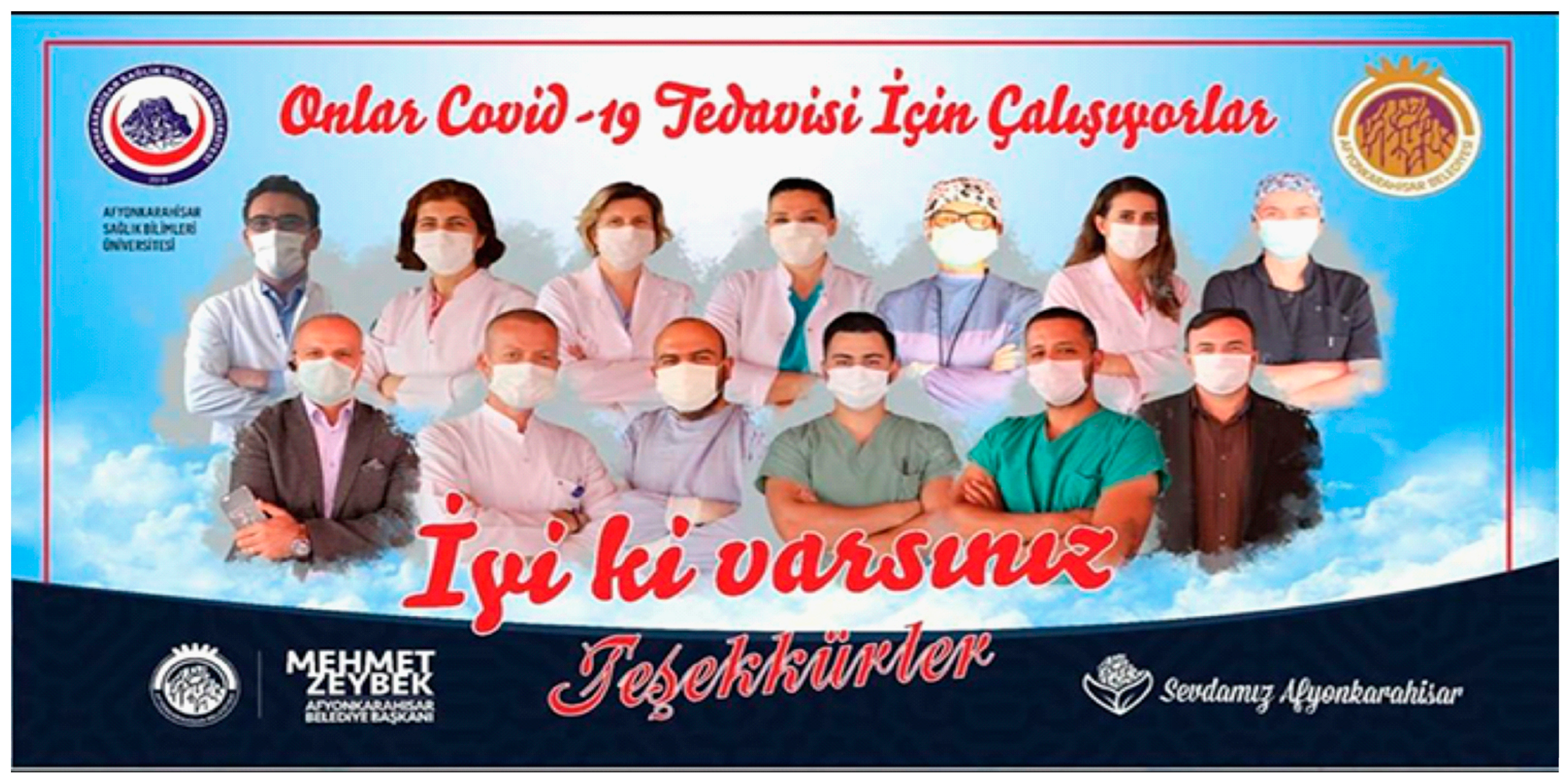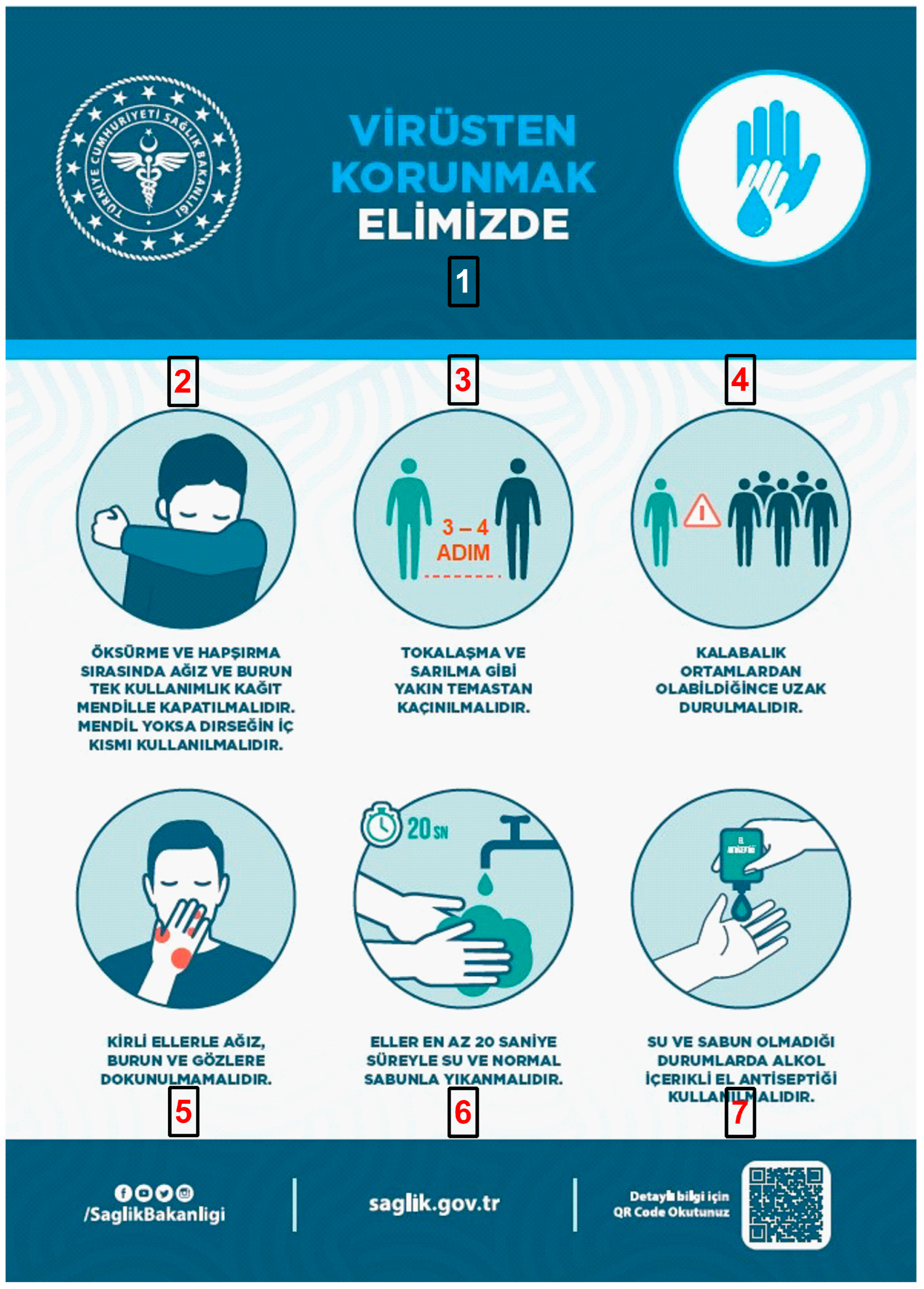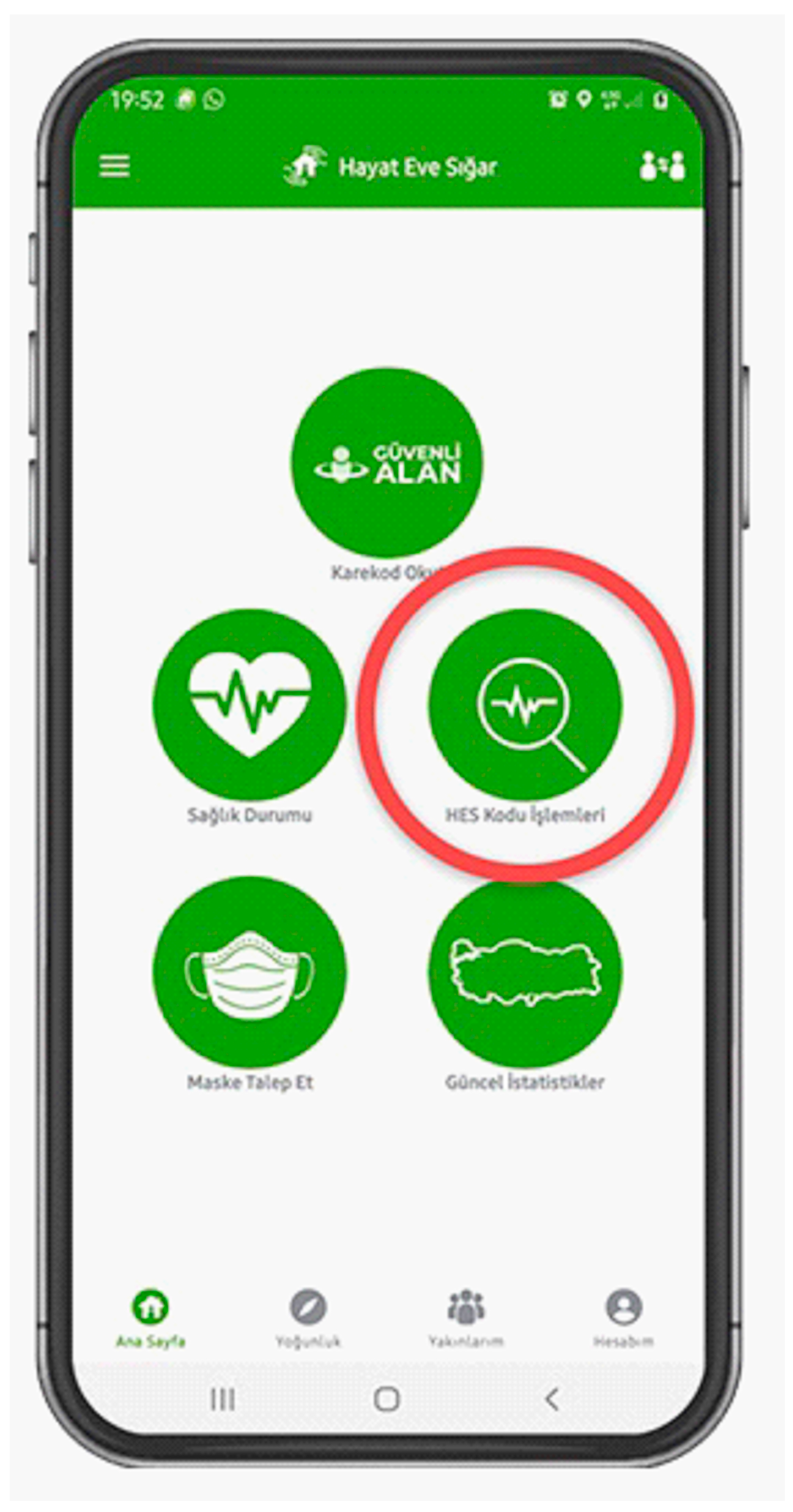The COVID-19 Pandemic Response and Its Impact on Post-Corona Health Emergency and Disaster Risk Management in Türkiye
Abstract
1. Introduction
2. Materials and Methods
2.1. Methods Setting
2.2. Literature Resources
3. Results
3.1. Human Resources
3.1.1. Medical Staff
3.1.2. Education and Preparation of Medical Staff
3.1.3. Supports to Medical Staff
3.2. Health Service Delivery
3.2.1. Hospitals and Intensive Care Units
3.2.2. Vaccination
3.3. Logistics
3.3.1. Public Logistics
3.3.2. Social Logistics
3.3.3. Technical Logistics
4. Discussion
4.1. Ethics
4.2. Vulnerability
4.3. Sustainability
4.4. Management
5. Conclusions
Funding
Institutional Review Board Statement
Informed Consent Statement
Data Availability Statement
Conflicts of Interest
References
- Kisa, S.; Kisa, A. Under-Reporting of COVID-19 Cases in Turkey. Int. J. Health Plan. Manag. 2020, 35, 1009–1013. [Google Scholar] [CrossRef] [PubMed]
- Aykaç, N.; Yasin, Y. Rethinking the First COVID-19 Death in Turkey. Turk. Thorac. J. 2020, 21, 291–292. [Google Scholar] [CrossRef] [PubMed]
- The Ministry of Health Current Status in Türkiye. Available online: https://covid19.saglik.gov.tr/TR-66935/genel-koronavirus-tablosu.html (accessed on 17 October 2023).
- Sirkeci, I.; Murat Yüceşahin, M. Coronavirus and Migration: Analysis of Human Mobility and the Spread of COVID-19. Migr. Lett. 2020, 17, 379–398. [Google Scholar] [CrossRef]
- Yener, D. Türkiye’nin Koronavirüsle Mücadele Politikasına “Bilim Kurulu” Yön Veriyor; Anadolu Agency: Ankara, Türkiye, 2020. [Google Scholar]
- Cantekin, K. Turkey: Government Takes Extraordinary Administrative Measures for the Coronavirus Pandemic. Available online: https://www.loc.gov/item/global-legal-monitor/2020-03-24/turkey-government-takes-extraordinary-administrative-measures-for-the-coronavirus-pandemic/ (accessed on 17 October 2023).
- The Ministry of Health. COVID-19 Vaccination Information Platform—Last Report; The Ministry of Health: Ankara, Türkiye, 2023. [Google Scholar]
- Ghotbi, N. The COVID-19 Pandemic Response and Its Impact on Post-Corona Health Emergency and Disaster Risk Management in Iran. Sustainability 2022, 14, 14858. [Google Scholar] [CrossRef]
- Lamberti-Castronuovo, A.; Parotto, E.; Della Corte, F.; Hubloue, I.; Ragazzoni, L.; Valente, M. The COVID-19 Pandemic Response and Its Impact on Post-Corona Health Emergency and Disaster Risk Management in Italy. Front. Public. Health 2022, 10, 1034196. [Google Scholar] [CrossRef]
- Chen, A.P.; Hansoti, B.; Hsu, E.B. The COVID-19 Pandemic Response and Its Impact on Post-Pandemic Health Emergency and Disaster Risk Management in the United States. Sustainability 2022, 14, 16301. [Google Scholar] [CrossRef]
- Park, J.; Min, J.; Song, J.H.; Park, M.Y.; Yoo, H.; Kwon, O.; Yang, M.; Kim, S.; Lee, J.; Myong, J.P. The COVID-19 Pandemic Response and Its Impact on Post-Corona Health Emergency and Disaster Risk Management in Republic of Korea. Sustainability 2023, 15, 3175. [Google Scholar] [CrossRef]
- Ishimaru, T.; Shimizu, S.; Teshima, A.; Ibayashi, K.; Arikado, M.; Tsurugi, Y.; Tateishi, S.; Okawara, M. The Impact of COVID-19 Outbreak on Health Emergency and Disaster in Japan. Sustainability 2022, 14, 15686. [Google Scholar] [CrossRef]
- Demirbilek, Y.; Pehlivantürk, G.; Özgüler, Z.Ö.; Meşe, E.A.L.P. COVID-19 Outbreak Control, Example of Ministry of Health of Turkey. Turk. J. Med. Sci. 2020, 50, 489–494. [Google Scholar] [CrossRef]
- Ülker, V.; Taşkın, H.C.; Yardımcı, N.; Hocagil, A.C.; Hocagil, H. Overcrowding Is Still a Big Problem for Our Emergency Services, Real Disaster Is in Our Emergency Departments in Turkey. Prehospital Disaster Med. 2017, 32, S32. [Google Scholar] [CrossRef]
- Erenler, A.K.; Akbulut, S.; Guzel, M.; Cetinkaya, H.; Karaca, A.; Turkoz, B.; Baydin, A. Reasons for Overcrowding in the Emergency Department: Experiences and Suggestions of an Education and Research Hospital. Turk. J. Emerg. Med. 2014, 14, 59–63. [Google Scholar] [CrossRef] [PubMed]
- Cakir, O.D.; Cevik, S.E.; Bulut, M.; Guneyses, O.; Aydin, S.A. Emergency Department Overcrowding in Turkey: Reasons, Facts and Solutions. J. Nepal. Med. Assoc. 2014, 52, 878–885. [Google Scholar] [CrossRef]
- Çirakli, Ü.; Orhan, M.; Sayar, B.; Demiray, E.K.D. Impact of COVID-19 on Emergency Service Usage in Turkey: Interrupted Time Series Analysis. Intern. Emerg. Med. 2023, 18, 2105–2112. [Google Scholar] [CrossRef] [PubMed]
- Çınaroğlu, S. Distribution of Health Human Resources in Turkey in Provincial Level and a Need for More Effective Policy. Hacet. J. Health Adm. 2021, 24, 235–254. [Google Scholar]
- The Ministry of Health. Elektif İşlemlerin Ertelenmesi ve Diğer Alınacak Tedbirler; The Turkish Ministry of Health: Ankara, Türkiye, 2020; pp. 1–2. [Google Scholar]
- Nesanır, N.; Bahadır, A.; Karcıoğlu, Ö.; Korur Fincancı, Ş. Pandemi Sürecinde Türkiye’de Sağlık Çalışanı Ölümlerinin Anlattığı; Turkish Medical Association (TTB): Ankara, Türkiye, 2022. [Google Scholar]
- Selçuk, F.Ü.; Solak Grassie, S. Psychosocial Predictors and Mediators Relating to the Preventive Behaviors of Hospital Workers during the COVID-19 Pandemic in Turkey. J. Occup. Environ. Med. 2023, 65, 255–260. [Google Scholar] [CrossRef] [PubMed]
- Kackin, O.; Ciydem, E.; Aci, O.S.; Kutlu, F.Y. Experiences and Psychosocial Problems of Nurses Caring for Patients Diagnosed with COVID-19 in Turkey: A Qualitative Study. Int. J. Soc. Psychiatry 2021, 67, 158–167. [Google Scholar] [CrossRef]
- Şahin, M.K.; Aker, S.; Şahin, G.; Karabekiroğlu, A. Prevalence of Depression, Anxiety, Distress and Insomnia and Related Factors in Healthcare Workers During COVID-19 Pandemic in Turkey. J. Community Health 2020, 45, 1168–1177. [Google Scholar] [CrossRef]
- Ayaslıer, A.A.; Albayrak, B.; Çelik, E.; Özdemir, Ö.; Özgür, Ö.; Klrlmll, E.; Kayl, İ.; Sakarya, S. Burnout in Primary Healthcare Physicians and Nurses in Turkey during COVID-19 Pandemic. Prim. Health Care Res. Dev. 2023, 24, e4. [Google Scholar] [CrossRef]
- Batu, M.; Kalaman, S.; Tos, O.; Subaşı, H. Active Healthcare Professionals’ Perception of COVID-19 and Their Communication with Their Children: A Qualitative Analysis of the Background of the Pandemic. Türk. İlet. Araştırmaları Derg. 2021, 8, 35–54. [Google Scholar] [CrossRef]
- Özlü, A.; Akdeniz Leblebicier, M.; Ünver, G.; Bulut Özkaya, D. Evaluation of Musculoskeletal Pain and Physical Activity of Health Care Workers Taking Part in the Covid-19 Pandemia. Kocatepe Med. J. 2023, 24, 105–111. [Google Scholar]
- The Ministry of Health. Sağlık Bakanlığına Bağlı Sağlık Tesislerinde Görevli Personele Ek Ödeme Yapılmasına Dair Yönetmelik; The Ministry of Health: Ankara, Türkiye, 2020. [Google Scholar]
- Arık, Ö.; Aydoğdu, A. Investigation of Opinions of Health Staff about COVID-19 Additional Payment by the Ministry of Health. Int. J. Acad. Value Stud. (JAVStudies JAVS) 2021, 3, 231–242. [Google Scholar] [CrossRef]
- World Health Organization (WHO). COVID-19 Strategic Preparedness and Response Plan: Operational Planning Guidelines to Support Country Preparedness and Response; World Health Organization: Geneva, Switzerland, 2020. [Google Scholar]
- The Ministry of Health. Pandemic Influenza National Preparedness Plan; The Ministry of Health: Ankara, Turkey, 2016. [Google Scholar]
- Kartoglu, U.; Pala, K. Evaluation of COVID-19 Pandemic Management in Türkiye. Front. Public. Health 2023, 11. [Google Scholar] [CrossRef]
- Bezircioğlu, I.; Dinç Horasan, G.; Seval-Çelik, Y.; Güner Akdoğan, G.; Hayran, M.; İnan, S.; Şemin, İ.; Dayanç, B.E.; Demir, A.B.; Abacıoğlu, Y.H. COVID-19 Pandemic Effect in Medical Education: “Izmir University of Economics Experience. Tıp Eğitimi Dünyası 2021, 20, 102–108. [Google Scholar] [CrossRef]
- Selçuk University. Faculty of Medicine Activity Report on Medical Education during Pandemic; Selçuk University: Konya, Türkiye, 2021. [Google Scholar]
- Council of Higher Education (YÖK). YÖK’ten Salgın Sürecinde Doktor Adaylarının Mezuniyetlerini Kolaylaştıracak Yeni Karar; General Secreteriat of Council of Higher Education: Ankara, Türkiye, 2020. [Google Scholar]
- The Ministry of the Interior. Koronavirüs ile Mücadele Kapsamında-Yeni Kısıtlama ve Tedbirler Genelgeleri; The Ministry of the Interior: Ankara, Türkiye, 2020. [Google Scholar]
- Turkish Medical Association (TTB). Tıp Fakültesi Son Sınıf Eğitiminde Yaratılan Kargaşa Giderilmeli, Öğrencilerin Mağdur Olmaları Önlenmelidir; Statement of Turkish Medical Association (TTB): Ankara, Türkiye, 2019. [Google Scholar]
- (TEB), T.P.A. Maske Teminindeki Sorunlar Çözülmelidir. Available online: https://covid19.teb.org.tr/news/8833/Maske_Teminindeki_Sorunlar_Çözülmelidir (accessed on 17 October 2023).
- Asu, G.; Gemlik, H.N. A Qualitative Study on the Problems and Solution Proposals of Healthcare Employees in the Field during the COVID-19 Pandemic Process. J. Health Serv. Educ. 2020, 4, 45–52. [Google Scholar] [CrossRef]
- Kader, C.; Erbay, A.; Demirel, M.S.; Kocabiyik, O.; Ciftci, E.; Yalcın-Colak, N.; Unsal, G.; Eren-Gok, S. Evaluation of Attitudes and Behaviors of Healthcare Professionals towards COVID-19 Vaccination. Klimik Derg./Klimik J. 2022, 35, 30–35. [Google Scholar] [CrossRef]
- Sert Karaaslan, Y. Sağlık Çalışanlarına Yönelik Ilk doz Aşılamada Sona Gelindi; Anadolu Agency: Ankara, Türkiye, 2021. [Google Scholar]
- (TEB) Turkish Pharmacists’ Association. FIP Sağlık Danışmanlığı COVID-19 Kılavuzları; Turkish Pharmacists’ Association: Ankara, Türkiye, 2020. [Google Scholar]
- The Ministry of Health. COVID-19 Rehberi; The Ministry of Health: Ankara, Türkiye, 2020. [Google Scholar]
- KLIMIK—Turkish Society of Clinical Microbiology and Infectious Diseases. COVID-19: Bilgi Notları ve Dernek Görüşleri; General Secreteriat of Turkish Society of Clinical Microbiology and Infectious Diseases: Ankara, Türkiye, 2020. [Google Scholar]
- The Ministry of Health. Health Statistics Yearbook—2020; The Ministry of Health: Ankara, Türkiye, 2022. [Google Scholar]
- The Ministry of Health. COVID-19: Temaslı Takibi, Salgın Yönetimi, Evde Hasta İzlemi ve Filyasyon; The Ministry of Health: Ankara, Türkiye, 2021. [Google Scholar]
- The Ministry of Health. COVID-19 National Strategy for the Implementation of Vaccines; The Ministry of Health: Ankara, Türkiye, 2021. [Google Scholar]
- Haznedaroğlu Benlioğlu, E.; Bayrak Durmaz, S.; Göksal, K. COVID-19 Vaccination Hesitancy among Patients Admitted to the Immunology and Allergy Clinic with Drug Allergies. Health Sci. Q. 2023, 3, 219–227. [Google Scholar] [CrossRef]
- Şahin, H. The Reasons for the COVID-19 Anti-Vaccine in Turkey: Twitter Example. Anemon 2022, 10, 579–593. [Google Scholar] [CrossRef]
- Sonmezer, M.C.; Sahin, T.K.; Erul, E.; Ceylan, F.S.; Hamurcu, M.Y.; Morova, N.; Al, I.R.; Unal, S. Knowledge, Attitudes, and Perception towards COVID-19 Vaccination among the Adult Population: A Cross-Sectional Study in Turkey. Vaccines 2022, 10, 278. [Google Scholar] [CrossRef]
- Erciyes University COVID-19 Aşı Yerli ve Milli Aşısı Hakkında. Available online: https://ikum.erciyes.edu.tr/tr/duyuru-detay/covid-19-asi-yerli-ve-milli-asisi-hakkinda (accessed on 17 October 2023).
- Official Newspaper. Bazı Alacakların Yeniden Yapılandırılması İle Bazı Kanunlarda Değişiklik Yapılması Hakkında Kanun; Türkiye, 2020. Available online: https://www.resmigazete.gov.tr/eskiler/2023/03/20230312-14.htm (accessed on 17 October 2023).
- Ergezen, A.K. Social Support Programs during COVID-19 Outbreak in Turkey. Gazi Med. J. 2020, 31, 322–324. [Google Scholar] [CrossRef]
- Derneği, İ.H.; Dertli, N. COVID-19 Pandemisi Sürecinde Ekonomik ve Sosyal Haklar Raporu; Turkish Human Rights Association: Ankara, Türkiye, 2020. [Google Scholar]
- Bulut, H.G.; Demir, M. Social Support Polcies Applied in Türkiye during the COVID-19 Pandemin Process. J. Bus. Entrep. Res. 2022, 1, 36–47. [Google Scholar]
- The Ministry of National Education. Eba. Available online: https://www.eba.gov.tr/ (accessed on 17 October 2023).
- Boylu, E.; Isık, P.; Isık, Ö.F. COVID-19 Pandemic and Emergency Distance Turkish Teaching. Turk. Online J. Distance Educ. 2022, 23, 212–234. [Google Scholar] [CrossRef]
- Işık, O.; Tengilimoğlu, D.; Şenel Tekin, P.; Tosun, N.; Zekioğlu, A. Evaluation of Students’ Opinions Regarding Distance Learning Practices in Turkish Universities during the COVID-19 Pandemic. Yuksekogretim Derg. 2021, 11, 607–616. [Google Scholar] [CrossRef]
- Alan, Ü. Distance Education during the COVID-19 Pandemic in Turkey: Identifying the Needs of Early Childhood Educators. Early Child. Educ. J. 2021, 49, 987–994. [Google Scholar] [CrossRef] [PubMed]
- Yaylak, E. Distance Education in Turkiye During the COVID-19 Pandemic: What Do Stakeholders Think? Turk. Online J. Distance Educ. 2022, 23, 65–92. [Google Scholar] [CrossRef]
- Ünal, E.C. Ücretsiz Maske Dağıtımında Başvurular E-Devlet Kapısı Üzerinden Alınacak; Anadolu Agency: Ankara, Türkiye, 2020. [Google Scholar]
- Demirel, A.C.; Sütçü, S. Evaluation of Applications and Services for the Elderly during the COVID-19 Outbreak in Turkey. OPUS Int. J. Soc. Res. 2021, 17, 1–35. [Google Scholar] [CrossRef]
- Çimen, H. Rethinking the Importance of Social Assistance in Turkey During the Pandemic That Shocked the World (COVID 19). Anadolu Üniversitesi İktisadi ve İdari Bilim. Fakültesi Derg. 2021, 22, 15–38. [Google Scholar] [CrossRef]
- Erbay, H. On Medical Ethics, Story and Narrating. Turk. J. Bioeth. 2017, 4, 29–35. [Google Scholar]
- Çamlıtepe, M. The Effect of Digital Technologies About Performing Arts and Music Practices in the Pandemic Process. Balk. Music. Art. J. 2022, 4, 1–10. [Google Scholar] [CrossRef]
- Commission. COVID-19 Stories, 1st ed.; Cander, B., Yakıncı, C., Eds.; Inonu University Press: Malatya, Turkey, 2020. [Google Scholar]
- The Presidency of Religious Affairs Prayers Rose from the Minarets. Available online: https://diyanet.gov.tr/tr-TR/Kurumsal/Detay/29429/minarelerden-semaya-dualar-yukseldi# (accessed on 17 October 2023).
- Largent, E.A.; Miller, F.G. The Legality and Ethics of Mandating COVID-19 Vaccination. Perspect. Biol. Med. 2021, 64, 479–493. [Google Scholar] [CrossRef]
- Erbay, H. Herding Cats: Ethics in Prehospital Triage. Signa Vitae 2022, 18, 15–22. [Google Scholar] [CrossRef]
- De Oliveira, A.C.A.X.; Paumgartten, F.J.R. Ethical Issues in Placebo-Controlled Trials of COVID-19 Vaccines. Cad. Saude Publica 2021, 37, e00007221. [Google Scholar] [CrossRef] [PubMed]
- Freckelton, I. Human Challenge Trials: Ethical and Legal Issues for COVID-19 Research. J. Law. Med. 2021, 28, 311–322. [Google Scholar] [PubMed]
- Öncü, M.A.; Yildirim, S.; Bostanci, S.; Erdoğan, F. The Effect of COVID-19 Pandemic on Health Management and Health Services: A Case of Turkey. Duzce Med. J. 2021, 23, 61–70. [Google Scholar] [CrossRef]
- Coccolini, F.; Cicuttin, E.; Cremonini, C.; Tartaglia, D.; Viaggi, B.; Kuriyama, A.; Picetti, E.; Ball, C.; Abu-Zidan, F.; Ceresoli, M.; et al. A Pandemic Recap: Lessons We Have Learned. World J. Emerg. Surg. 2021, 16, 46. [Google Scholar] [CrossRef] [PubMed]
- Yildirim, D.; Kocatepe, V. Professional Values and Ethical Sensitivities of Nurses in COVID-19 Pandemic. Nurs. Forum 2022, 57, 1111–1119. [Google Scholar] [CrossRef]
- Soylar, P.; Ulucan, M.; Dogan Yuksekol, O.; Baltaci, N.; Ersogutcu, F. Ethical Problems among Nurses during Pandemics: A Study from Turkey. Ethics Med. Public. Health 2022, 22, 100796. [Google Scholar] [CrossRef]
- Aliyu, A.A. Public Health Ethics and the COVID-19 Pandemic. Ann. Afr. Med. 2021, 20, 157–163. [Google Scholar]
- Tan, S.Y.; De Foo, C.; Verma, M.; Hanvoravongchai, P.; Cheh, P.L.J.; Pholpark, A.; Marthias, T.; Hafidz, F.; Prawidya Putri, L.; Mahendradhata, Y.; et al. Mitigating the Impacts of the COVID-19 Pandemic on Vulnerable Populations: Lessons for Improving Health and Social Equity. Soc. Sci. Med. 2023, 328, 116007. [Google Scholar] [CrossRef]
- Zhang, Y.; Wu, Q.; Zhang, T.; Yang, L. Vulnerability and Fraud: Evidence from the COVID-19 Pandemic. Humanit. Soc. Sci. Commun. 2022, 9, 424. [Google Scholar] [CrossRef]
- Girotto, S. Vulnerability and the COVID-19 Pandemic: Educating to a New Notion of Health. Int. J. Ethics Educ. 2023, 8, 291–307. [Google Scholar] [CrossRef]
- Peñalba, E. Pandemic and Social Vulnerability: The Case of the Philippines. In The Societal Impacts of COVID-19: A Transnational Perspective; Istanbul University Press: Istanbul, Türkiye, 2021; pp. 203–219. [Google Scholar]
- The Lancet Redefining Vulnerability in the Era of COVID-19. Lancet 2020, 395, 1089. [CrossRef] [PubMed]
- Özer, M. Educational Policy Actions by the Ministry of National Education in the Times of COVID-19 Pandemic in Turkey. Kastamonu Eğitim Derg. 2020, 28, 1124–1129. [Google Scholar] [CrossRef]
- World Health Organization (WHO). WHO Delivers Advice and Support for Older People during COVID-19. Available online: https://www.who.int/news-room/feature-stories/detail/who-delivers-advice-and-support-for-older-people-during-covid-19 (accessed on 17 October 2023).
- Ilgili, Ö.; Gökçe Kutsal, Y. Impact of COVID-19 among the Elderly Population. Turk. J. Geriatr. 2020, 23, 419–423. [Google Scholar] [CrossRef]
- The Ministry of Family and Social Services Engelli ve Yaşlı Gündüz Yaşam Merkezleri Yeniden Hizmet Vermeye Başladı. Available online: https://www.aile.gov.tr/eyhgm/haberler/engelli-ve-yasli-gunduz-yasam-merkezleri-yeniden-hizmet-vermeye-basladi/ (accessed on 17 October 2023).
- Demir, B.; Mandıracıoğlu, A. Discriminatory Practices towards the Elderly during the COVID-19 Pandemic and Assessment of the Situation on the Elderly People. Ege J. Med. 2021, 60, 181–190. [Google Scholar] [CrossRef]
- Wyszyński, M.; Grudziński, M.; Pokonieczny, K.; Kaszubowski, M. The Assessment of COVID-19 Vulnerability Risk for Crisis Management. Appl. Sci. 2022, 12, 4090. [Google Scholar] [CrossRef]
- Yaşar, Ö.; Avcı, N. Changing Elderliness Perception: The Elders Stigmatized By COVID-19. J. Turk. Stud. 2020, 15, 1251–1273. [Google Scholar] [CrossRef]
- Karasu, F.; Öztürk Çopur, E.; Ayar, D. The Impact of COVID-19 on Healthcare Workers’ Anxiety Levels. J. Public Health 2022, 30, 1399–1409. [Google Scholar] [CrossRef]
- Gokkaya, B.; Yazici, T.N.; Kargul, B. Perceived Stress and Perceived Vulnerability at Healthcare Workers during COVID-19 Pandemic. Clin. Exp. Health Sci. 2022, 12, 431–438. [Google Scholar] [CrossRef]
- Onan, N.; Dinc, S.; Demir, Z. Pandemic Process from the Window of Healthcare Professionals. Value Health Sci. 2022, 12, 474–482. [Google Scholar]
- Keten Edis, E. Experiences of Intensive Care Nurses in the COVID-19 Process: A Qualitative Study. Gümüşhane Univ. J. Health Sci. 2022, 11, 476–486. [Google Scholar]
- Dincer, B.; Inangil, D. The Effect of Emotional Freedom Techniques on Nurses’ Stress, Anxiety, and Burnout Levels during the COVID-19 Pandemic: A Randomized Controlled Trial. Explore 2021, 17, 109–114. [Google Scholar] [CrossRef] [PubMed]
- Murat, M.; Köse, S.; Savaşer, S. Determination of Stress, Depression and Burnout Levels of Front-Line Nurses during the COVID-19 Pandemic. Int. J. Ment. Health Nurs. 2021, 30, 533–543. [Google Scholar] [CrossRef] [PubMed]
- Kahraman, B.; Uğur, T.D.; Girgin, D.; Koçak, A.B. COVID-19 Döneminde Yaşlı Olmak: 65 Yaş ve Üzeri Bireylerin Pandemi Sürecinde Yaşadığı Sorunlar. Hacet. Univ. Edeb. Fak. Derg. 2022, 39, 124–143. [Google Scholar] [CrossRef]
- Yurtsever, M. Short-Term Effects of COVID-19 Pandemic on the Environment. Uludağ Univ. J. Fac. Eng. 2020, 25, 1611–1636. [Google Scholar] [CrossRef]
- Council of Higher Education (YÖK). Yükseköğretim Kurumlarında Uzaktan Öğretime İlişkin Usul ve Esaslar; Council of Higher Education (YÖK): Ankara, Turkey, 2020. [Google Scholar]
- Ahsan, M. Strategic Decisions on Urban Built Environment to Pandemics in Turkey: Lessons from COVID-19. J. Urban. Manag. 2020, 9, 281–285. [Google Scholar] [CrossRef]
- Chimed-Ochir, O.; Amarsanaa, J.; Ghotbi, N.; Yumiya, Y.; Kayano, R.; Van Trimpont, F.; Murray, V.; Kubo, T. Impact of COVID-19 on Health Emergency and Disaster Risk Management System: A Scoping Review of Healthcare Workforce Management in COVID-19. Sustainability 2023, 15, 11668. [Google Scholar] [CrossRef]
- The Ministry of Interior. AFAD-Strategic Plan 2019–2023; The Ministry of Interior: Ankara, Türkiye, 2018. [Google Scholar]
- Commission Ethical Disaster Resilience for Our Global Community: Tenth Youth Looking Beyond Disaster (LBD19) Training Workshop-Istanbul. Available online: https://www.eubios.info/youth_looking_beyond_disaster_lbd/lbd10_istanbul (accessed on 17 October 2023).
- The Ministry of Health Pandemik Influenza Ulusal Hazırlık Planı. Available online: https://hsgm.saglik.gov.tr/depo/Yayinlarimiz/Eylem_Planlari/Ulusal_Pandemi_Hazirlik_Plani.pdf (accessed on 17 October 2023).
- AFAD Kahramanmaraş 2019 Ulusal TAMP Tatbikatı Gerçekleştirildi. Available online: https://kahramanmaras.afad.gov.tr/kahramanmaras-ulusal-deprem-tatbikati-gerceklestirildi (accessed on 17 October 2023).
- The Governorship of Osmaniye COVID-19 Pandemi Acil Durum Planı. Available online: https://osmaniyeisg.meb.gov.tr/meb_iys_dosyalar/2020_04/20115003_ACYL_DURUM_EYLEM_PLANI_COVYD_19-SON.pdf (accessed on 17 October 2023).
- Gürbüz, Y.; Şencan, İ. Pandemic Preparedness and Action Plan. Türk. Klin. J. Inf. Dis. 2010, 3, 40–48. [Google Scholar]
- The Ministry of Family and Social Services COVID-19 Pandemisi Yönetimi ve Eylem Planı Rehberi. Available online: https://www.csgb.gov.tr/media/68340/kiplas-covid-19-pandemisi-yonetimi-ve-eylem-plani-26022021.pdf (accessed on 17 October 2023).
- Mert, S.; Sayilan, A.A.; Karatoprak, A.P.; Baydemir, C. The Effect of COVID-19 on Ethical Sensitivity. Nurs. Ethics 2021, 28, 1124–1136. [Google Scholar] [CrossRef]





| Themes | Sub-Themes |
|---|---|
| Human Resources |
|
| |
| |
| Health Service Delivery |
|
| |
| Logistics |
|
| |
|
Disclaimer/Publisher’s Note: The statements, opinions and data contained in all publications are solely those of the individual author(s) and contributor(s) and not of MDPI and/or the editor(s). MDPI and/or the editor(s) disclaim responsibility for any injury to people or property resulting from any ideas, methods, instructions or products referred to in the content. |
© 2024 by the author. Licensee MDPI, Basel, Switzerland. This article is an open access article distributed under the terms and conditions of the Creative Commons Attribution (CC BY) license (https://creativecommons.org/licenses/by/4.0/).
Share and Cite
Erbay, H. The COVID-19 Pandemic Response and Its Impact on Post-Corona Health Emergency and Disaster Risk Management in Türkiye. Sustainability 2024, 16, 826. https://doi.org/10.3390/su16020826
Erbay H. The COVID-19 Pandemic Response and Its Impact on Post-Corona Health Emergency and Disaster Risk Management in Türkiye. Sustainability. 2024; 16(2):826. https://doi.org/10.3390/su16020826
Chicago/Turabian StyleErbay, Hasan. 2024. "The COVID-19 Pandemic Response and Its Impact on Post-Corona Health Emergency and Disaster Risk Management in Türkiye" Sustainability 16, no. 2: 826. https://doi.org/10.3390/su16020826
APA StyleErbay, H. (2024). The COVID-19 Pandemic Response and Its Impact on Post-Corona Health Emergency and Disaster Risk Management in Türkiye. Sustainability, 16(2), 826. https://doi.org/10.3390/su16020826





